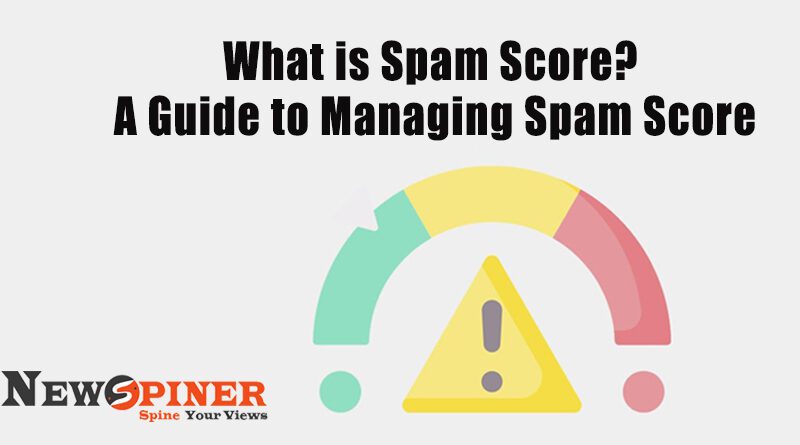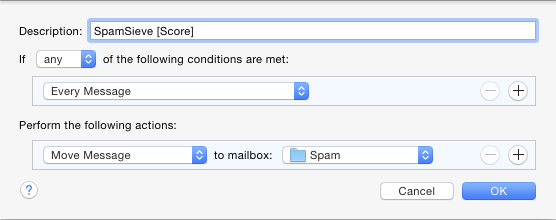

- #Spamsieve score for mac os x#
- #Spamsieve score mac os x#
- #Spamsieve score full#
- #Spamsieve score registration#
- #Spamsieve score software#

Send questions to More columns at tried many ways to can spam, and I can't say any of them is even 99 percent effective. Glenn Fleishman writes the Practical Mac column for Personal Technology and about technology in general for The Seattle Times and other publications. My technique has reduced the 1,000-plus spams a day I used to receive to a few dozen, which are easily filtered for later review.
#Spamsieve score full#
By talking to your Internet service provider or company mail administrator, you might be able to get the full benefit. My three lines of defense involve a Mac only at the bottom level. After a couple of weeks training it with individual messages it mismarked as good or bad, the accuracy is more than 99 percent. I found that SpamSieve had more than 95 percent accuracy after feeding it the good and bad sets. You can then filter incoming messages through your e-mail program based on whether SpamSieve has marked it as probable spam. The program creates a statistical picture of how words are used in e-mail you receive. Via one of the supported programs above, you tell SpamSieve to analyze your sets of spam and ham. To use SpamSieve, you need two relatively large sets of spam and ham e-mail. Apple's mail filtering uses its version of Bayesian filtering. It works with all the major Macintosh e-mail programs: Eudora, Entourage, Emailer, Mailsmith and PowerMail.
#Spamsieve score registration#
SpamSieve requires registration at $20, and it's worth it.

#Spamsieve score software#
Blog software developer Benjamin Trott, of SixApart, makers of MovableType, details how at My final line of defense is SpamSieve ( It uses Bayesian filtering, a system that analyzes samples of spam and ham that you provide to build a picture of what words are most likely to occur at what frequency in good and bad e-mail.
#Spamsieve score mac os x#
You can install SpamAssassin underneath Mac OS X as a sort of local filtering agent, but it's rather complex.
#Spamsieve score for mac os x#
There are tools to allow direct communication with SpamAssassin, but not for Mac OS X ( /). Others, including Seattle's Speakeasy and the national EarthLink, have their own server-based tools that can block spam before you download your e-mail. Many ISPs and businesses employ SpamAssassin by default or as an option with a Web interface to configure it. I've found this works extremely well, having a very small number of false positives - ham marked as spam accidentally - and most of those are messages from mailing lists I've opted into that look a little like spam. E-mails with a score of 4 to 8 are marked as spam but delivered. I have several of my mail server's users' accounts set up at their request to toss any e-mail receiving a score of eight or higher, which indicates a very high likelihood that it's spam. SpamAssassin applies the score and then you can filter at the server or client based on the number. The rules include checking databases of reported spam and analyzing common spam techniques, such as sentences containing all capital letters. SpamAssassin ( is free software that can be installed on a server to examine incoming e-mail and apply a set of complex rules to it. The next layer of defense is SpamAssassin, which I put into effect in January before a trip to Montana when I worried a dial-up connection might be overwhelmed just downloading the headers of all the spam I would have to delete. It also rejects mail that purports to come from domains that don't exist. I run a mail server for myself and a few colleagues and friends, and the mail-server software is configured to check well-run blacklists and reject mail from servers that spew out or at least relay it from spammers. My first line of defense for several years is one routinely used by Internet service providers (ISPs) and information technology (IT) departments. The most notable exceptions are in e-mail clients, such as the filter that's part of the adequate mail application Apple Computer offers with Mac OS X, and the junk-mail filter that can learn a bit and be adjusted with Microsoft's Entourage mail and contact software. Macintosh users have traditionally had less access to spam tools, and that's still the case. (You can read more about policy and general e-mail issues in my colleague Charlie Bermant's regular Inbox column.) Last month, experts say, more spam was received than "ham," which is a growing term for the shrinking category of good e-mail from people you know or that you opted-in to receive.Īlthough many people have solutions for reducing spam, from jailing and fining spammers to revamping all the technology on the Internet used to deliver e-mail, I've deployed three tiers of spam avoidance that have made my inbox tolerable. Instead, it's the reality of receiving e-mail on the Internet.


 0 kommentar(er)
0 kommentar(er)
